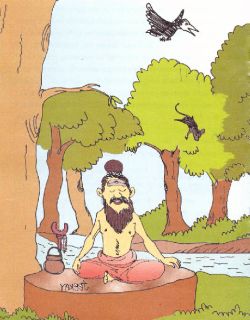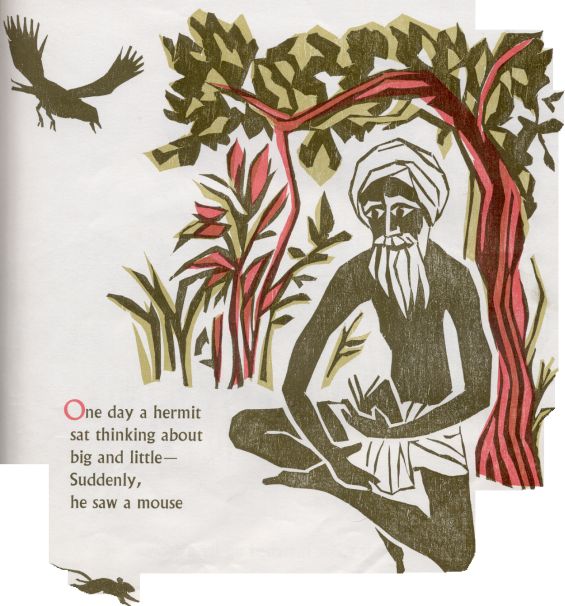"The Hermit and the Mouse," a folk tale from the Hitopadesha
A popular folk tale of India is the story of the hermit and the mouse told in the Sanskrit collection of fables and tales called Hitopadesha. The Hitopadesha was composed in the 12th century, but much of its content originated in the 3rd century BCE Panchatantra, which was widely translated in India, Persia, and Arabic-speaking countries.
The tales are told as counsels to wise rulers or those who would be wise, for the lessons or morals having practical application to politics and statescraft. Thus, early translations into English by Sir Edwin Arnold (1861) and Frederic Pincott (1886) retain this structure for the chapter headings and the narrative links between the tales. However, the tales, not unlike Aesop or other popular sources, are readily adaptable to the interest of children.
In "The Hermit and the Mouse" is told the story of a hermit (magician, sage, recluse, saint, holy man) who rescues a mouse from destruction by a crow. In turn, he rescues the crow from a cat, the cat into a dog, and so forth, each time using his magic powers to transform the smaller creature into a larger one. The predictable outcome of the story's convention sees the large version of the mouse, an enormous tiger who plots to kill the hermit and thus retain his outer form and power, thwarted by the hermit, who perceives the beast's thoughts and turns it back into its original lowly form.
Edwin Arnold 1861 version (from The Book of Good Counsels):
In the forest of the Sage Gautama there dwelt a Recluse named Mighty-at-Prayer. Once, as he sat at his frugal meal, a young mouse dropped beside him from the beak of a crow, and he took it up and fed it tenderly with rice grains. Some time after the Saint observed a cat pursuing his dependent to devour it, whereupon he changed the mouse into a stout cat. The cat was a great deal harassed by dogs, upon which the Saint again transformed it into a dog. The dog was always in danger of the tigers, and his protector at last gave him the form of a tiger -- considering him all this while, and treating him withal, like nothing but a mouse. The country-folk passing by would say, "That a tiger! not he; it is a mouse the Saint has transformed." And the mouse being vexed at this, reflected, "So long as the Master lives, this shameful story of my origin will survive!" With this thought he was about to take the Saint's life, when he, who knew his purpose, turned the ungrateful beast by a word to his original shape.
Pincott 1886 version:
[The vulture explains:] A low fellow should never be placed in the position of the great. For thus it is said: A low fellow, having attained, a position of dignity, desires to cut off (his) master; as the mouse, having reached the state of a tiger, tried to kill the saint. Spotted-colour asked, "How (was) that?" The vulture related (as follows):
There was, in the grove of the divine philosopher Gautama, a saint named Great-austerity. In the vicinity of the hermitage a young mouse, (which) had dropped from the mouth of a crow, was found by him; (and) was afterwards nourished with grains of wild rice, by that compassionate saint. By-and-bye, a cat was seen by the saint running after the mouse to eat (it); thereupon, by the power of his devotion, the mouse was transformed into a very strong cat. But the cat, also, (was) timid of a dog; therefore (he) made it a dog; (but) the dog (had) great fear of a tiger; there-upon (he) made it a tiger. Now the saint perceives him, though a tiger, no different from a mouse; hence all the people dwelling there, seeing a tiger, say: "This mouse has been brought to the condition of a tiger by this saint." Hearing this, the tiger uneasily reflected: "As long as this saint shall live, so long the disgraceful story of my origin will not disappear." Having thus reflected he rose up to slay the saint; (but) the saint knowing his design, said "Become a mouse again," (and) immediately made him a mouse. Hence I say, "A low fellow, having attained an exalted station," &tc.
 G.
L. Chandiramni
1995 version:
G.
L. Chandiramni
1995 version:
"The Tale of the Recluse and
the Mouse" from his
Tales of Hitopadesha
for Children.
Long ago, in a hermitage, there lived a great sage. One day, as he sat down to have his lunch, a mouse fell from the beak of a crow, on the ground near him. He picked the mouse up, took him inside the ashram and fed him some rice.
One day, the sage saw a cat chasing the mouse around the ashram. He was afraid that his pet mouse would be killed by the cat. By the power of his penance, he turned the mouse into a cat so that it could defend itself against other cats.
Soon a dog appeared on the scene and started barking at and chasing the cat. When the sage saw this, he changed the cat into a dog.
One day his dog was frightened by a tiger. The sage immediately changed his dog into a tiger, again by the power of his penance.
However, the sage always treated the tiger as if it was still his little mouse. Whenever the villagers who passed by the sage's ashram saw the tiger, they would say, "Ha! That's not a tiger! It's just a mouse that the sage changed into a tiger. He won't eat us or even scare us."
When the tiger heard this, he was furious. "As long as the sage is alive," he thought, "the truth about my real nature will never die. I must get rid of him for good." The tiger decided to kill the sage.
But as soon as the sage saw him coming towards him, he knew what was going on in the tiger's mind. He shouted, "Get back into your form of a mouse." No sooner had he uttered these words than the tiger shrank and became a little mouse once again. The sage looked at him with pity and said, "Whatever one is, large or small, it's good to be humble."
Marcia Brown version (1961): Once A Mouse.
Finally, too, there is the modern adaption of the tale
by children's writer Marcia Brown in her 1961 Once A Mouse, both
a classic of illustration and of text understatement.
The book intimately
captures the flavor of the Indian
folk tale. The illustrations are realistic; the hermit has the
appearance of a sadhu. The text follows
the original intent, using the term "hermit"
exclusively to describe the protagonist of the tale. By
establishing at the outset that the hermit is reflecting on "big and
little" the reader is
presented a microcosm of the political context in which the tale was
originally told, here brought to simplicity (for children if not
for philosophy) as "big and little."

¶
